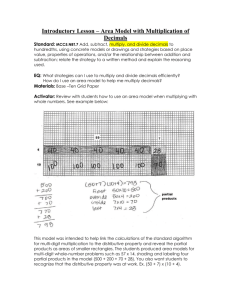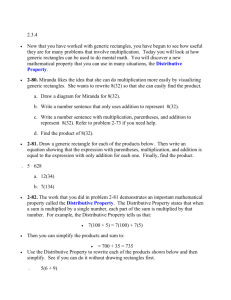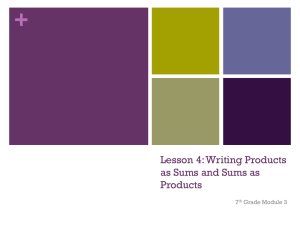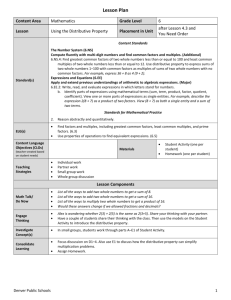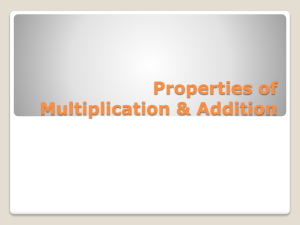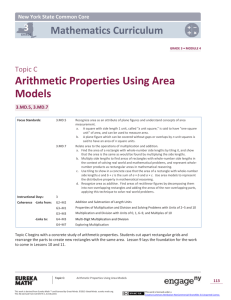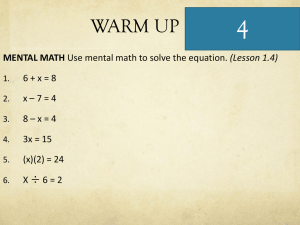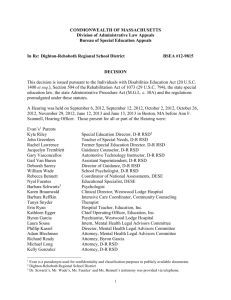ACE 4.2
advertisement
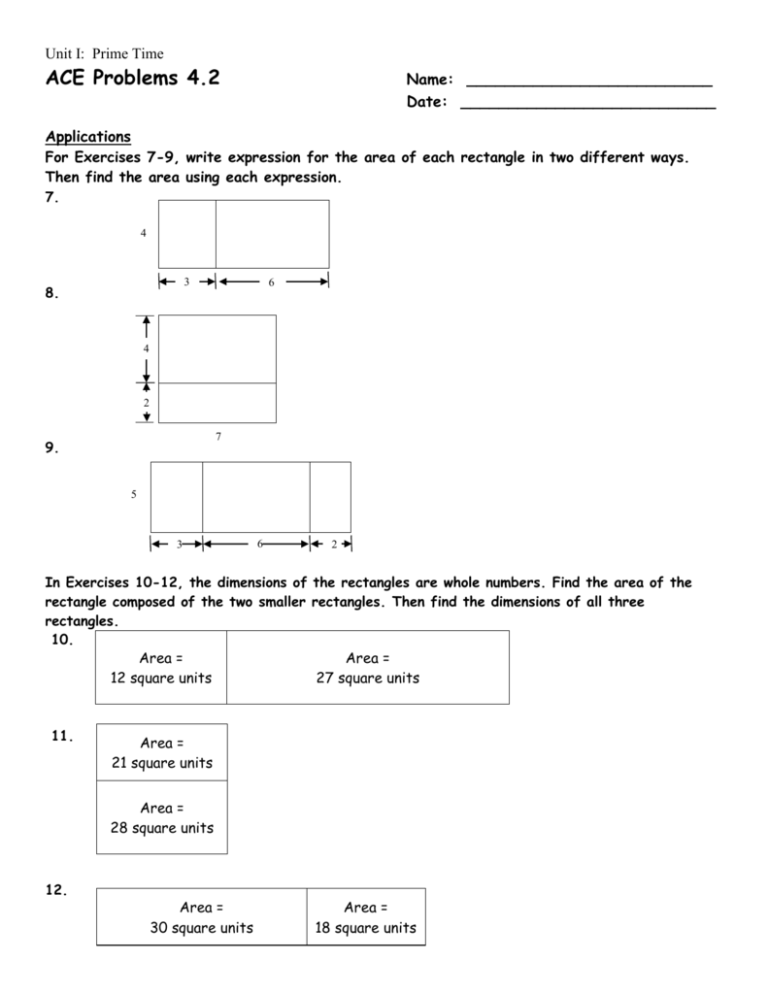
Unit I: Prime Time ACE Problems 4.2 Name: __________________________ Date: ___________________________ Applications For Exercises 7-9, write expression for the area of each rectangle in two different ways. Then find the area using each expression. 7. 4 3 8. 6 4 2 7 9. 5 3 6 2 In Exercises 10-12, the dimensions of the rectangles are whole numbers. Find the area of the rectangle composed of the two smaller rectangles. Then find the dimensions of all three rectangles. 10. Area = Area = 12 square units 27 square units 11. Area = 21 square units Area = 28 square units 12. Area = 30 square units Area = 18 square units Unit I: Prime Time For Exercises 13-16, draw a rectangle with the given width and length. Then use the Distributive Property to write each area as a product and as a sum. 13. 3 and (4 + 6) 14. 3 and (5 + 1 + 3) 15. N and (2 + 6) 16. 5 and (N + 2) For Exercises 17-18, use the area of a rectangle and the Distributive Property to find each product. 17. 9 X 34 18. 35 X 18 19. a. Write 60 as the sum of two numbers. b. Write 60 as the product of two numbers. c. Write 60 as the product of two factors. In your expression, write one of the factors as a sum of two numbers. Find an equivalent way to write this expression. Unit I: Prime Time 20. a. 90 = 20 + 70. Use the Distributive Property and the GCF of 20 and 70 to write another related expression for 90. Could you write another expression with a different common factor? b. 90 = 36 + 54. Use the Distributive Property and the GCF of 36 and 54 to write another related expression for 90. Could you write another expression with a different common factor? 21. Consider a 3-by-3 grid. Choose four numbers, such as 2, 8,6, and 3. Write the numbers along the border of the grid as shown. 6 3 Sum 2 8 Sum Enter the product of the numbers into the corresponding cells. 6 3 2 12 6 8 48 24 Sum Sum Add across the rows and column. 6 3 Sum 2 12 6 18 8 48 24 72 Sum 60 30 90 a. What is the relationship between the bold number in the lower right-hand cell and the italicized numbers along the edges of the grid? b. Start a new 3-by-3 grid. Pick another set of numbers for the border. Does the same relationship hold for the lower right-hand cell and the numbers along the edges? Sum Sum c. Shalala claims she used the Distributive Property to show that the sum of the numbers in the bottom row was the same as the sum of the numbers in the last column. Do you agree? Explain. Unit I: Prime Time For Exercises 22-23, use rectangles to show that each statement is true. 22. 3(7 + 2) = 3(7) + 3(2) 23. 3(6) + 5(2) = 5(6 + 2) Connections For Exercises 67-74, find the sum, difference, product, or quotient. 67. 50 X 70 68. 39 + 899 69. 25 X 70 70. 4,400 – 1,200 71. 2,200 ÷ 22 72. 9,900 ÷ 99 73. 50 X 120 74. 580 + 320 Extensions 88. Evan found a way to find the product of 36 X 15. He drew this diagram and wrote these computations. 30 6 4 10 300 60 5 150 30 36 x 15 = (30 + 6) (10 + 5) = 300 + 150 + 60 + 30 = 540 a. Does Evan’s method work for finding 36 X 15? Explain. b. Use Evan’s method to find (2 + n) (3 + 5). #88 continues on the next page Unit I: Prime Time c. Use Evan’s method to find (n + 2) (a + 3). d. Use Evan’s method to find (a + b) (c + d). 89. Use the Distributive Property to prove each statement. Hint: You can write an even number as 2n and an odd number as 2n + 1, where n represents any whole number. a. The sum of two even numbers is even. b. The sum of two odd numbers is even. c. The sum of an odd number and an even number is odd. 90. Use a rectangular model to show that the equations below are true. a. 3(3 + 1+ 7) = 3(3) + (1) + 3(7) b. a(b + c+ d) = a(b) + a(c) + a(d) for any four whole numbers a, b, c, and d.
